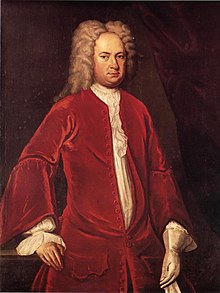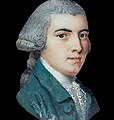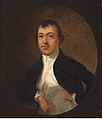
The First Families of Virginia, or FFV, are a group of early settler families who became a socially and politically dominant group in the British colony of Virginia and later the Commonwealth of Virginia. They descend from European colonists who primarily settled at Jamestown, Williamsburg, the Northern Neck and along the James River and other navigable waters in Virginia during the 17th century. These elite families generally married within their social class for many generations and, as a result, most surnames of First Families date to the colonial period.
The American Revolution cut ties with Britain but not with its social traditions. While some First Family members were loyal to Britain, others were Whigs who supported and often took leading roles in the Revolution. Most First Families remained in Virginia, where they flourished as tobacco planters, and from the sale of slaves to the cotton states to the south. Indeed, many younger sons of the First Families were relocated into the cotton belt to start their own plantations. With the emancipation of slaves during the Civil War and the consequential loss of slave labor, Virginia plantations struggled to turn a profit. The First Families, albeit poorer than before, maintained social and political leadership. Marshall Fishwick says that by the 1950s, "the old-time aristocracy not given up, or sunk into decadence as Southern novelists suggest." They adopted modern agricultural technology and co-opted rich "Yankees" into their upper-class, rural horse-estate society. However, mirroring the fortunes of other White Anglo-Saxon Protestant social groups, the political and financial influence of the First Families in Virginia has declined over the last century.
English heritage, second sons

The English colonists who eventually became the First Families emigrated to the new Colony of Virginia. Their migration took place from the settlement of Jamestown through the English Civil War and English Interregnum period (1642–1660). Some royalists left England on the accession to power of Oliver Cromwell and his Parliament. Because most of Virginia's leading families recognized Charles II as King following the execution of Charles I in 1649, Charles II reputedly called Virginia his "Old Dominion" – a nickname that endures today. The affinity of many early Virginia settlers for the Crown led to the term "distressed Cavaliers", often applied to the Virginia plantocracy. Some Cavaliers who served under King Charles I fled to Virginia. FFVs often refer to Virginia as "Cavalier Country". These men were offered land or other rewards by King Charles II, but most who had settled in Virginia stayed in Virginia.
Many such early settlers in Virginia were called Second Sons. Primogeniture favored the first sons' inheriting lands and titles in England. Second or third sons went out to the colonies to make their fortune, or entered the military and the clergy. Tidewater Virginia evolved as a society descended from second or third sons of Englishmen who inherited land grants or land in Virginia. They formed part of what became the Southern elite in Colonial America.
In some cases, longstanding ties among families in England were carried to the new colony, where they were reinforced by marriage and other relations. For instance, there were ancestral ties between the Spencer family of Bedfordshire and the Washington family; a Spencer secured the land grant later purchased by the Washingtons, where they built their Mount Vernon home. These sorts of ties were common in the early colony, as families shuttled back and forth between England and Virginia, maintaining their connections with the mother country and with each other.
A thin network of increasingly interrelated families made up the planter elite and held power in colonial Virginia. "As early as 1660, every seat on the ruling Council of Virginia was held by members of five interrelated families," writes British historian John Keegan, "and as late as 1775, every council member was descended from one of the 1660 councillors."
The ties among Virginia families were based on marriage. In a pre-Revolutionary War economy dependent on the production of tobacco as a commodity crop, the ownership of the best land was tightly controlled. It often passed between families of corresponding social rank. The Virginia economy was based on slave labor as the colony became a slave society. The landed gentry could keep tight rein on political power, which passed in somewhat orderly fashion from family to family. (In the more modern mercantile economy of the north, social mobility became more prominent. The power of the elite was muted by newcomers who gained wealth in the market economy.)
Pocahontas

Pocahontas (1595–1617), a Native American, was the daughter of Chief Powhatan, founder of the Powhatan Confederacy. According to Mattaponi and Patawomeck tradition, Pocahontas was previously married to a Patawomeck weroance, Kocoum, who was murdered by Englishmen when Samuel Argall abducted her on April 13, 1613. Educated among the English of Virginia and converted to Christianity during her captivity in Henricus, Pocahontas married colonist John Rolfe at a church in Jamestown on April 5, 1614. Rolfe had become prominent and wealthy as the first to successfully develop an export cash crop for the colony with new varieties of tobacco. Their only child, Thomas Rolfe, was born on January 30, 1615. He married and had a family: his descendants married into other elite families.
Pocahontas was much celebrated in London, where she was welcomed with great ceremony at the Royal Court. She died young but became legendary as the first Indian from Virginia to become Christian, marry an Englishman, and have a known child from such a marriage (there were no doubt mixed-race children born to lower-class colonists and Algonquian women, although they may have been neither married nor Christian). She became an important symbol of friendly Native American-English relations of the Jamestown colony. By virtue of many fictional accounts, her marriage was romanticized and became part of the mythology of early American history.
Crucially, Pocahontas became a focal point in all First Family genealogies. So great was the importance of Pocahontas in these family trees that, upon the passage of the Racial Integrity Act of 1924, First Family lobbying resulted in the "Pocahontas Exception", which allowed white people claiming native descent to circumvent the Act's one-drop rule and remain classified as white.
Organizing the FFV
In 1887, following the Reconstruction era after the Civil War, Virginia Governor Wyndham Robertson wrote the first history of Pocahontas and her descendants, delineating the ancestry of FFV families including the Bollings, Clements, Whittles, Blands, Skipwiths, Flemings, Catletts, Gays, Jordans, Randolphs, Tazewells, and many others. Excluded from this history were 'natural children', mixed-race descendants of unions with slaves.
Families often used surnames as given names, as in the "Johns" of Johns Hopkins University, or where a surname might die out because the last holder only had daughters, Cole Digges was the grandson of William Cole. A mother's maiden name might also be used as a middle name, to document that part of the person's ancestry; or even middle and first as is the case with John Tayloe Lomax, John Tayloe Washington, and John Tayloe Corbin. For example, Lt. Col. Powhatan Bolling Whittle of the 38th Virginia Infantry, Confederate States Army was an uncle of Matoaka Whittle Sims.
In 1907, the Jamestown Exposition was held near Norfolk to celebrate the tricentennial of the arrival of the first English colonists and the founding of Jamestown. Preservation Virginia, formerly known as the Association for the Preservation of Virginia Antiquities, was founded in Williamsburg in 1889 to memorialize Virginia history. In the 20th century, Preservation Virginia emphasized patriotism by highlighting the Founding Fathers that hailed from Virginia. To commemorate the 350th anniversary of the first settlement at Jamestown, the Order of First Families of Virginia published genealogies compiled by F.A.S.G. Annie Lash Jester and Martha Woodroff Hiden in 1956. The same pair published a second addition in 1964 (also during Virginia's Massive Resistance crisis). The third edition was compiled and edited by Virginia M. Meyer (1974-1981) and John Federick Dorman (1981-1987). The fourth and current edition, in three volumes published between 2004 (vol.1) and 2007 (vol.3)by Baltimore's Genealogical Publishing Company in collaboration with the Order of First Families of Virginia.
Notable families
See also: Category:First Families of VirginiaSome notable family names include:
- Allerton
- Archer
- Ashford
- Bacon
- Baskerville
- Belcher
- Bentley
- Berkeley
- Beverley
- Billingsley
- Blair
- Bland
- Bolling
- Branch
- Braxton
- Browne
- Buckner
- Burwell
- Byrd
- Capps
- Carter
- Cary
- Chiles
- Christian
- Conway
- Custis
- Dalton
- Dameron/Damron
- Dandridge
- Eldridge
- Fairfax
- Farrar
- Fitzhugh
- Gooch
- Graves
- Harrison
- Hill
- Hopkins
- Howell
- Jameson
- Jefferson
- Jenings
- Kennon
- Lee
- Madison
- Marshall
- Mathews
- McLean
- Nelson
- Norvell
- Pace
- Page
- Payne
- Randolph
- Robinson
- Rolfe
- Saunders
- Scrivener
- Selden
- Sharp
- Shifflett
- Skillern
- Spencer
- Stagner
- Stanton
- Starnes
- Stith
- Taliaferro
- Tayloe
- Taylor
- Terrell
- Tucker
- Waller
- Warner
- Warren
- Washington
- West
Portrait gallery
-
 James Blair (clergyman)
James Blair (clergyman)
-
 Richard Bland
Richard Bland
-
 Robert Bolling
Robert Bolling
-
 William Byrd II of Westover Plantation
William Byrd II of Westover Plantation
-
 Landon Carter I
Landon Carter I
-
 Robert Carter, Portrait at Shirley Plantation
Robert Carter, Portrait at Shirley Plantation
-
 Robert Carter III by Thomas Hudson
Robert Carter III by Thomas Hudson
-
 Col. John Dandridge Jr
Col. John Dandridge Jr
-
 Colonel William Fairfax (1691–1757)
Colonel William Fairfax (1691–1757)
-
 William Fitzhugh
William Fitzhugh
-
 Sir William Gooch
Sir William Gooch
-
 Benjamin Harrison V Portrait
Benjamin Harrison V Portrait
-
 William Henry Harrison by James Reid Lambdin
William Henry Harrison by James Reid Lambdin
-
 Official Presidential portrait of Thomas Jefferson (by Rembrandt Peale, 1800)
Official Presidential portrait of Thomas Jefferson (by Rembrandt Peale, 1800)
-
 Col. John Jameson
Col. John Jameson
-
Col. Richard Lee I "The Immigrant"
-
Thomas Lee of Stratford Hall
-
 Francis Lightfoot Lee, signer of the U.S. Declaration of Independence
Francis Lightfoot Lee, signer of the U.S. Declaration of Independence
-
 Richard Henry Lee by Charles Willson Peale, signer of the U.S. Declaration of Independence
Richard Henry Lee by Charles Willson Peale, signer of the U.S. Declaration of Independence
-
 Light-Horse Harry Lee by Gilbert Stuart
Light-Horse Harry Lee by Gilbert Stuart
-
 Warner Lewis II and Rebecca Lewis, John Wollaston
Warner Lewis II and Rebecca Lewis, John Wollaston
-
 James Madison by John Vanderlyn
James Madison by John Vanderlyn
-
 Col. John Page by Peter Lely
Col. John Page by Peter Lely
-
 John Page of Rosewell, Gloucester County, Virginia
John Page of Rosewell, Gloucester County, Virginia
-
 Mann Page and His Sister Elizabeth, John Wollaston
Mann Page and His Sister Elizabeth, John Wollaston
-
 Edmund Randolph
Edmund Randolph
-
 Peyton Randolph
Peyton Randolph
-
 Peyton Randolph
Peyton Randolph
-
 Thomas Mann Randolph Jr.
Thomas Mann Randolph Jr.
-
 William Randolph III of Wilton House circa 1755, John Wollaston
William Randolph III of Wilton House circa 1755, John Wollaston
-
 Speaker John Robinson
Speaker John Robinson
-
 John Tayloe I of the Old House
John Tayloe I of the Old House
-
 John Tayloe II of Mount Airy, Richmond County, Virginia, John Wollaston
John Tayloe II of Mount Airy, Richmond County, Virginia, John Wollaston
-
 John Tayloe III (Stuart) of The Octagon House
John Tayloe III (Stuart) of The Octagon House
Estate Gallery
-
 Bacon Family, Bacon's Castle Surry County, Virginia, oldest documented brick dwelling in the United States
Bacon Family, Bacon's Castle Surry County, Virginia, oldest documented brick dwelling in the United States
-
 Beverley Family, Blandfield, Caret, Essex County, Virginia
Beverley Family, Blandfield, Caret, Essex County, Virginia
-
 Browne Family, Four Mile Tree, Surry, Virginia
Browne Family, Four Mile Tree, Surry, Virginia
-
 Burwell Family, Carter's Grove, James City County, Virginia
Burwell Family, Carter's Grove, James City County, Virginia
-
 Byrd Family, Westover Plantation, Charles City County, Virginia
Byrd Family, Westover Plantation, Charles City County, Virginia
-
 Carter Family, Nomini Hall, Westmoreland County, Virginia
Carter Family, Nomini Hall, Westmoreland County, Virginia
-
 Wellford-Carter Family, Sabine Hall, Richmond Co, Virginia
Wellford-Carter Family, Sabine Hall, Richmond Co, Virginia
-
 Hill-Carter Family, Charles City County, Virginia
Hill-Carter Family, Charles City County, Virginia
-
Lee Family, Stratford Hall, Westmoreland County, Virginia
-
 Madison Family, Belle Grove, Carolina County, Virginia
Madison Family, Belle Grove, Carolina County, Virginia
-
 Page Family, Rosewell, Gloucester County, Virginia
Page Family, Rosewell, Gloucester County, Virginia
-
 Tayloe Family, Mount Airy, Richmond Co, Virginia
Tayloe Family, Mount Airy, Richmond Co, Virginia
-
 Taliaferro, Wellford, Burgh Westra, Gloucester, Virginia
Taliaferro, Wellford, Burgh Westra, Gloucester, Virginia
-
 Fitzhugh Family, Marmion, Comorn, Virginia
Fitzhugh Family, Marmion, Comorn, Virginia
See also
References
- Tyler, Lyon Gardiner, ed. (April 1915). "The F. F. V.'s of Virginia". William and Mary College Quarterly Historical Magazine. Richmond, Virginia: Whittet & Shepperson. page 277.
- Gutzman, Kevin R. C. (2007). Virginia's American Revolution: From Dominion tor Republic, 1776–1840. Lanham: Lexington Books. ISBN 978-0-7391-2131-3.
- Fishwick, Marshall (1959). "F. F. V.'s". American Quarterly. 11 (2): 147–156. doi:10.2307/2710671. JSTOR 2710671.
- Keegan, John (2009). The American Civil War. New York: Alfred A. Knopf. p. 334. ISBN 978-0-307-26343-8.
- Deyo, William "Night Owl" (September 5, 2009). "Our Patawomeck Ancestors" (PDF). Patawomeck Tides. 12 (1): 2–7. Archived from the original (PDF) on July 14, 2014. Retrieved July 6, 2014.
- Camilla Townsend, Pocahontas and the Powhatan Dilemma (2007)
- F. W. Gleach, Powhatan's world and colonial Virginia (1997)
- Kevin N. Maillard, The Pocahontas Exception: The Exemption of American Indian Ancestry from Racial Purity Law, 12 Mich. J. Race & L. 351 (2007).
- Wyndham Robertson, Pocahontas, alias Matoaka, and Her Descendants, Richmond VA: J. W. Randolph & English, 1887
- "Details for Roster ID 152". Historical Rosters Database. Virginia Military Institute. Archived from the original on October 9, 2015.
- Lt. Col. Powhattan Bolling Whittle, Victorian Villa: Sims-Mitchell history
- Blight, David (2002). Race and Reunion: The Civil War in American Memory (Paperback ed.). Belknap Press. ISBN 0-674-00332-2.
- Lindgren, James M. (1991). "'Virginia Needs Living Heroes': Historic Preservation in the Progressive Era". Public Historian. 13 (1): 9–24. doi:10.2307/3378156. JSTOR 3378156.
- front matter of 4th edition, isbn of vol. 1=0-8063-1744-2, of vol.2=0-8063-1763-9, of vol.3=978-0-8063-1775-5
- ^ Tyler, Lyon Gardiner, ed. (April 1915). "The F. F. V.'s of Virginia". William and Mary College Quarterly Historical Magazine. 23 (4). Richmond, Virginia: Whittet & Shepperson: 277. Retrieved February 11, 2011.
- Fischer, David Hackett (1991) . "The South of England to Virginia: Distressed Cavaliers and Indentured Servants, 1642–75". Albion's Seed: Four British Folkways in America. Oxford: Oxford University Press. pp. 219–220. ISBN 9780195069051.
Another unlikely 'FFV' was the wayward Pilgram Isaac Allerton, a London tailor's son who emigrated in the Mayflower to Plymouth Colony and resettled in Virginia, ca. 1655, where he married into Berkeley's ruling elite.
- ^ "Questions and Answers". Notes and Queries. VI (2). Manchester, New Hampshire: S. C. & L. M Gould: 244–245. February 1989.
- ^ Purvis, Thomas L. (1997) . "First families of Virginia". A Dictionary of American History. Malden, Massachusetts: Blackwell Publishers. p. 136. ISBN 9781577180999.
Among the most prominent of these lineages are those of the Bland, Blackwell Braxton, Breckenridge, Byrd, Carter, Chapman, Corbin, Fitzhugh, Harrison, Lee, Lindsey, Ludwell, Nelson, Randolph, Washington, and Wormley families.
- The William and Mary Quarterly
- "Custis Family".
- Bruce, Philip A., ed. (1894). "Mutiny in Virginia, 1635". Virginia Magazine of History and Biography. 1 (4): 419, 2nd footnote.
- Lexington, Eleanor (May 29, 1921). "Castle in Wales". Daily Arkansas Gazette. p. 10.
- Payne, Brooke (1937). The Payne's of Virginia. Richmond, Va: W. Byrd Press. ISBN 9780598483539. Retrieved June 26, 2018.
- Scadding, Henry (1987) . "Biographies". In Armstrong, Frederick H. (ed.). Toronto of Old. Toronto, Canada: J. Kirk Howard/Dundern Press Limited. p. 376. ISBN 9781550020274.
The Robinsons were one of the first families of Virginia where they settled about 1670, before becoming one of the first families of Upper Canada.
- Boddie, John Bennett (1974). Colonial Surry. Genealogical Publishing Com. ISBN 9780806300269.
Further reading
- Fischer, David Hackett (1989). Albion's Seed. Oxford University Press. ISBN 0-19-503794-4.
- Fishwick, Marshall (1959). "F. F. V.'s". American Quarterly. 11 (2): 147–156. doi:10.2307/2710671. JSTOR 2710671.
- Gutzman, Kevin R. C. (2007). Virginia's American Revolution: From Dominion to Republic, 1776–1840. Lanham: Lexington Books. ISBN 978-0-7391-2131-3.
- Willison, George F. Behold Virginia: the fifth crown. Being the trials, adventures & disasters of the first families of Virginia, the rise of the grandees & the eventual triumph of the common & uncommon sort in the Revolution (1951), popular history by a scholar
Notes on sources
- Note: Source 1: Captain William Tucker / Author: Barbara Jennifer Benefield / Publication: RootsWeb.com, May 12, 2004
- Note: Source 2 / Author: Doug Tucker / Publication: GenForum, January 16, 2006
- Note: Source 3 / Author: Marie Moore / Publication: RootsWeb.com, November 29, 2004 / "Note: died at sea"
- Note: Source 4 / Author: Phillip Judson Clark / Title: Royal Families and Others & also their Famous Descendants / Publication: rootsweb.com, January 1, 2008
External links
- "Becoming Virginians, The Story of America: A Virginian Experience", Virginia Historical Society, vahistoricalsociety.org